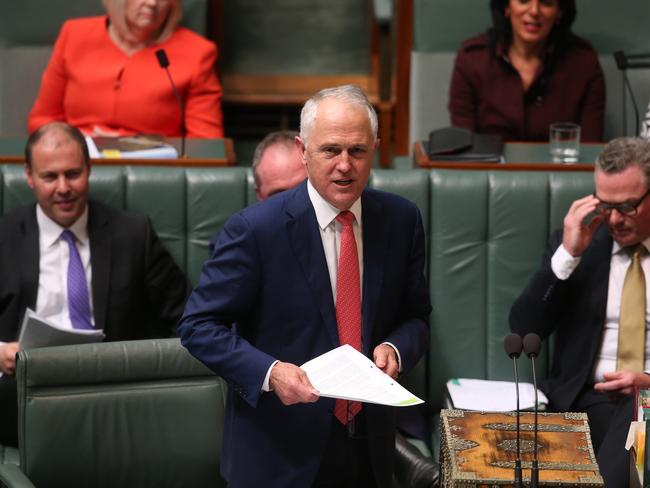Prime Minister’s 50c energy saving mocked
THE Government unveiled its “game-changing” energy policy today to save households an average of $115 a year.

PRIME Minister Malcolm Turnbull has described his energy policy released today as a “game-changer” that will save households money.
But it didn’t take long for confidential modelling to emerge raising questions over how meaningful the savings would be.
The PM and Energy Minister Josh Frydenberg held press conference today to launch the government’s National Energy Guarantee, which will require energy retailers to deliver a certain level of dispatchable energy as well as emissions reductions.
While they have been saying a $115 average yearly price reduction on power bills could be achieved under their reforms, the actual savings could be closer to $25.
Sky News reporter Samantha Maiden said she spoke to Australian Energy Market Commission chair John Pierce after the media event and he said there were actually three different modelling scenarios.
Sky reported that one scenario could see savings of just $25 a year from 2020 — or 50 cents a week — increasing to $2 a week in 2023 or $104 a year.
It didn’t take long for Labor to seize on the report, releasing an attack ad highlighting the difference in the two figures.
BREAKING: @samanthamaiden has already exposed Turnbull's energy 'plan'. This plan all about keeping him in power, not lowering power bills. pic.twitter.com/K9BpJJ0oV5
— Mark Butler MP (@Mark_Butler_MP) October 17, 2017
During the press conference Mr Pierce said the government’s estimate was an “average over 10 years” and a year-by-year figure was not yet available.
He said more detailed analysis and modelling would be done to provide “firmer estimates”.
He also pointed out that the wholesale price of electricity only made up between 30 and 40 per cent of the bill that households face, and the new national energy guarantee would not impact other costs such as for the “poles and wires”.
Labor spokesman Mark Butler said the Prime Minister had given up on renewable energy and not been prepared to give a price guarantee.
“At best it would appear that the broad analysis that has been undertaken would involve a 50 cent per week saving for households in three years time,” Mr Butler said.
The government’s plan is also controversial because it won’t be introducing a Clean Energy Target as recommended by Australia’s Chief Scientist Dr Alan Finkel as part of his review of the energy sector.
ANALYSIS: Ugly truth about Turnbull’s power promise
Figures presented to the coalition party room showed coal and gas would still contribute up to 72 per cent of energy in 2030, while Labor’s plan would cut this to 39 per cent.
But Mr Turnbull said his plan would deliver “affordability, reliability and responsibility”.
“No more industry policy, no more picking winners, no more favouring one technology after another, but simply ensuring that we have a reliable energy system, that we keep the lights on, that we do so in a way that is affordable and, of course, we meet those international commitments,” he told reporters.

Australian Solar Council chief John Grimes said his organisation would be launching a political campaign highlighting cuts to clean energy jobs.
The government will need the support of Labor, the Greens or crossbenchers to legislate a target for the electricity sector of a 26 per cent reduction in emissions on 2005 levels by 2030.
AGL boss Andy Vesey, whose company is weighing up whether to keep the coal-fired Liddell power station open beyond its 2022 closing date, said it was an important step.
“With bipartisan support, it will provide investment certainty,” Mr Vesey said.
Dr Finkel said it was a credible policy.
“We will see early wins on prices,” he said.
State energy ministers will meet in November to discuss the plan.
Former prime minister Tony Abbott was critical of the short discussion in the party room, saying the government should support the building of a new coal-fired power station.
— With AAP



